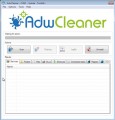If you web browser randomly being redirected to the redirecting.host web site, when you surf the World Wide Web with the FF, Google Chrome, Microsoft Internet Explorer and Microsoft Edge, then it could mean your PC is infected with adware (also known as ‘ad-supported’ software) from the big malware family. Once started, it may install a malicious internet browser’s extension that generates lots of pop-up ads or modify the internet browser’s settings to show ads on all web sites that you are opening in the browser, even on those web-pages where before you did not see any advertisements. We recommend you to clean you computer from ad supported software and thereby remove redirecting.host redirect. Complete the few simple steps below ASAP. It’ll remove the unwanted pop-up ads and protect your PC system from more dangerous applications and trojans.
The malicious software from the ad-supported software family that alters the settings of web-browsers usually affects only the FF, Chrome, Internet Explorer and MS Edge. However, possible situations, when any other internet browsers will be affected too. The ad supported software may change the Target property of a internet browser’s shortcut, so every time you open the web browser, instead of your home page, you will see the annoying redirecting.host advertisements.
While your machine is infected with the ad supported software, the Chrome, FF, MS Edge and Microsoft Internet Explorer may be redirected to redirecting.host unwanted web site. Of course, the adware may not cause damages to your files or Windows system, but it may open lots of unwanted advertisements. These ads will be injected within the content of web pages that are you opening in your web-browser and can be varied: pop-up ads, in-text ads, different sized banners, offers to install an questionable software. The ads will appear on all web-sites, including web sites where previously you have never seen any advertisements. In this case, when you open any site, you may see in your web browser’s status bar the following messages: ‘Waiting for redirecting.host’, ‘Transferring data from redirecting.host’, ‘Looking up redirecting.host’, ‘Read redirecting.host’, ‘Connected to redirecting.host’.
So, obviously, you need to remove the ad-supported software as soon as possible. Use the free instructions below. This guide will help you clean your machine and thereby remove the redirecting.host unwanted pop-ups.
How does redirecting.host advertisements get installed onto computer
I want to note that the ‘ad-supported’ software spreads in the composition together with various free programs. This means that you need to be very careful when installing programs downloaded from the Web, even from a large proven hosting. Be sure to read the Terms of Use and the Software license, select only the Manual, Advanced or Custom installation mode, switch off all additional modules and programs are offered to install. So, the negligence when running unknown software may lead to the fact that the adware is installed.
How to manually remove redirecting.host ads
The simple answer is right here on this page. We have put together simplicity and efficiency. It will allow you easily to clean your computer of ‘ad-supported’ software. Moreover, you can choose manual or automatic removal method. If you are familiar with the PC system then use manual removal, otherwise use the free anti-malware tool designed specifically to get rid of adware that causes annoying redirecting.host advertisements. Of course, you can combine both methods. Read this manual carefully, bookmark or print it, because you may need to close your browser or reboot your PC.
- Remove suspicious and unknown software by using Windows Control Panel
- Remove redirecting.host redirect from Firefox
- Remove redirecting.host redirect from Chrome
- Delete redirecting.host advertisements from Microsoft Internet Explorer
- Disinfect the browser’s shortcuts to remove redirecting.host redirect
- Get rid of unwanted Scheduled Tasks
Delete suspicious and unknown software by using Windows Control Panel
The best way to start the PC cleanup is to remove unknown and suspicious applications. Using the Windows Control Panel you can do this quickly and easily. This step, in spite of its simplicity, should not be ignored, because the removing of unneeded applications can clean up your browser from popup ads, hijackers and so on.
- If you are using Windows 8, 8.1 or 10 then press Windows key, click Search. Type “Control panel”and press Enter.
- If you are using Windows XP, Vista, 7, then press “Start” button and click “Control Panel”.
- It’ll display the Windows Control Panel.
- Click “Uninstall a program” under Programs category.
- You will see a list of all installed programs.
- Scroll through the all list, and uninstall suspicious and unknown programs. To quickly find the latest installed software, we recommend sort applications by date.
See more details in the video instructions below.
Remove redirecting.host redirect from Firefox
First, start the Firefox. Next, press the button in the form of three horizontal stripes (![]() ). It will open the drop-down menu. Next, press the “Help” button (
). It will open the drop-down menu. Next, press the “Help” button (![]() ).
).

In the Help menu, click the “Troubleshooting Information”. In the upper-right corner of the “Troubleshooting Information” page, click “Refresh Firefox” button.

Confirm your action, click the “Refresh Firefox”.
Remove redirecting.host redirect from Chrome
Open the Chrome menu by clicking on the button in the form of three horizontal stripes (![]() ). It opens the drop-down menu. Next, click the “Settings” option.
). It opens the drop-down menu. Next, click the “Settings” option.

Scroll down to the bottom of the page and click on the “Show advanced settings” link. Now scroll down until the Reset settings section is visible, as shown in the figure below and click the “Reset settings” button.
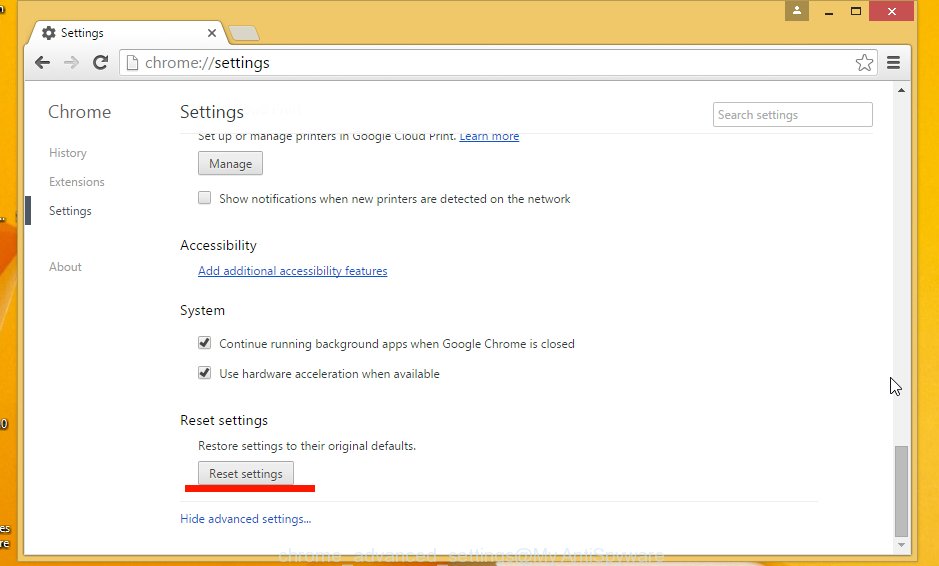
Confirm your action, press the “Reset” button.
Delete redirecting.host advertisements from Microsoft Internet Explorer
To remove the redirecting.host pop-ups you need to reset the Internet Explorer to the state, which was when the Windows was installed on your system.
First, start the Internet Explorer, then click ‘gear’ icon ![]() . It will open the drop-down menu on the right part of the web-browser, then click the “Internet Options” as shown in the figure below.
. It will open the drop-down menu on the right part of the web-browser, then click the “Internet Options” as shown in the figure below.

In the “Internet Options” screen, you need to select the “Advanced” tab and click the “Reset” button. The Internet Explorer will show the “Reset IE settings” dialog box as on the image below. Next, press the “Delete personal settings” check box to select it. After that, click the “Reset” button.

When the procedure is complete, click “Close” button. Close the IE and restart your computer for the changes to take effect. This step will help you to restore your browser’s settings to default state and disable ‘ad-supported’ extensions.
Disinfect the browser’s shortcuts to remove redirecting.host redirect
Now you need to clean up the browser shortcuts. Check that the shortcut referring to the right exe-file of the internet browser, and not on any unknown file. Right click to a desktop shortcut for your web browser. Choose the “Properties” option.
It will display the Properties window. Select the “Shortcut” tab here, after that, look at the “Target” field. The ‘ad-supported’ software can replace it. If you are seeing something similar “…exe http://web.site.address” then you need to remove “http…” and leave only, depending on the web-browser you are using:
- Google Chrome: chrome.exe
- Opera: opera.exe
- Firefox: firefox.exe
- Internet Explorer: iexplore.exe
Look at the example on the screen below.
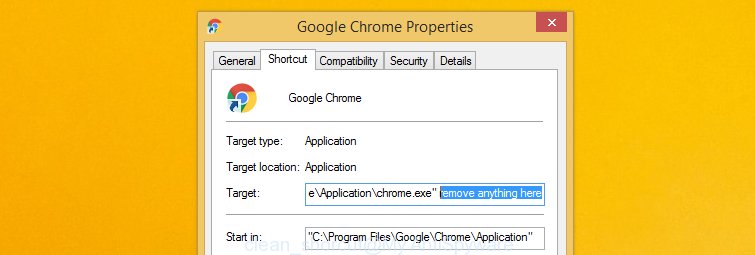
Once is finished, click the “OK” button to save the changes. Please repeat this step for internet browser shortcuts which redirects to an annoying sites. When you have completed, go to next step.
Get rid of unwanted Scheduled Tasks
Once installed, the adware can add a task in to the Windows Task Scheduler Library. Due to this, every time when you start your system, it will show redirecting.host annoying web page. So, you need to check the Task Scheduler Library and remove all tasks that have been created by ‘ad-supported’ programs.
Press Windows and R keys on your keyboard together. It will display a dialog box which called Run. In the text field, type “taskschd.msc” (without the quotes) and click OK. Task Scheduler window opens. In the left-hand side, click “Task Scheduler Library”, as on the image below.
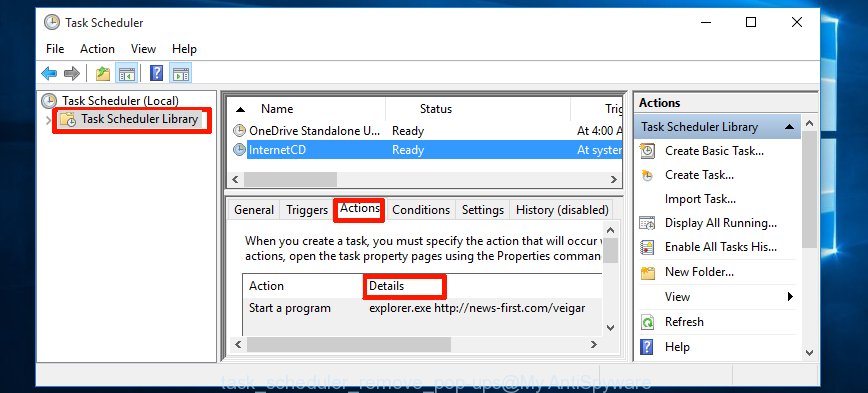
Task scheduler, list of tasks
In the middle part you will see a list of installed tasks. Select the first task, its properties will be display just below automatically. Next, press the Actions tab. Necessary to look at the text which is written under Details. Found something such as “explorer.exe http://site.address” or “chrome.exe http://site.address” or “firefox.exe http://site.address”, then you need remove this task. If you are not sure that executes the task, then google it. If it is a component of the malicios application, then this task also should be removed.
Further click on it with the right mouse button and select Delete as shown on the image below.

Task scheduler, delete a task
Repeat this step, if you have found a few tasks that have been created by adware. Once is complete, close the Task Scheduler window.
How to remove redirecting.host pop-up ads with free malware remover
Remove redirecting.host ads manually is difficult and often the adware is not completely removed. Therefore, we recommend you to use the Malwarebytes Free which are completely clean your machine. Moreover, the free program will help you to get rid of malware, web browser hijacker and toolbars that your computer may be infected too.
- Download Malwarebytes using the link below. Malwarebytes Anti-malware
327714 downloads
Author: Malwarebytes
Category: Security tools
Update: April 15, 2020
- Close all software and windows on your system. Open the file location. Double-click on the icon that’s named mb3-setup.
- This will open the setup of Malwarebytes. Next, click Next button and follow the prompts.
- When installation is finished, click on the “Scan Now” button for checking your PC system for the adware which redirects your internet browser to the redirecting.host annoying site. This procedure can take some time, so please be patient.
- Once the scan is complete, make sure all entries have “checkmark” and click “Quarantine Selected”. When the disinfection is finished, you may be prompted to reboot your PC system.
These steps above are shown in detail in the following video guide.
Stop redirecting.host redirect and other unwanted web pages
To increase your security and protect your computer against new unwanted advertisements and malicious pages, you need to use application that stops access to malicious ads and sites. Moreover, the program can block the open of intrusive advertising, which also leads to faster loading of pages and reduce the consumption of web traffic.
Download AdGuard program by clicking on the following link.
27034 downloads
Version: 6.4
Author: © Adguard
Category: Security tools
Update: November 15, 2018
When downloading is finished, launch the file named adguardInstaller. You will see the “Setup Wizard” screen as shown on the image below.

Follow the prompts. Once the installation is finished, you will see a window like below.

You can click “Skip” to close the setup program and use the default settings, or press “Get Started” button to see an quick tutorial that will allow you get to know AdGuard better.
In most cases, the default settings are enough and you do not need to change anything. Each time, when you run your personal computer, AdGuard will start automatically and block pop-ups, sites like redirecting.host, as well as other malicious or misleading web pages. For an overview of all the features of the program, or to change its settings you can simply double-click on the AdGuard icon, which is located on your Windows desktop.
Remove redirecting.host and malicious extensions with AdwCleaner.
If MalwareBytes cannot remove the unwanted redirecting.host pop-up ads from the Google Chrome, Firefox, Microsoft Edge and Microsoft Internet Explorer, then we suggests to use the AdwCleaner. AdwCleaner is a free removal tool for adware, browser hijackers, PUPs and toolbars.
Download AdwCleaner using the link below.
225786 downloads
Version: 8.4.1
Author: Xplode, MalwareBytes
Category: Security tools
Update: October 5, 2024
After downloading is finished, open the directory in which you saved it. Double click the AdwCleaner icon. Once this utility is started, you will see a screen such as below.
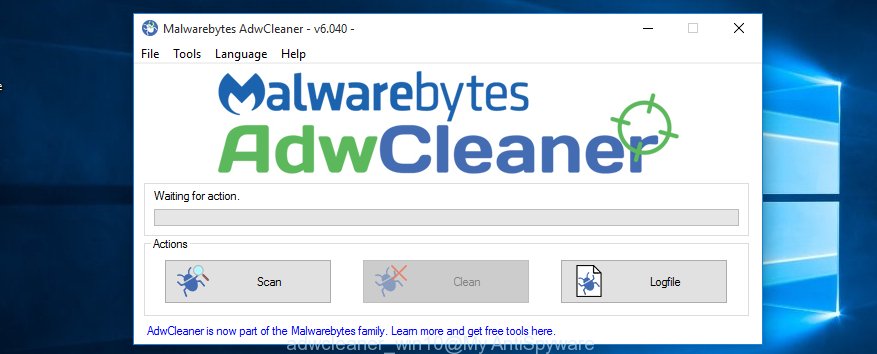
Now, press the “Scan” button to begin scanning your machine for the malicious extensions and ad supported software that displays ads from redirecting.host web-page. Once the scan is complete, it will display a scan report as shown below.
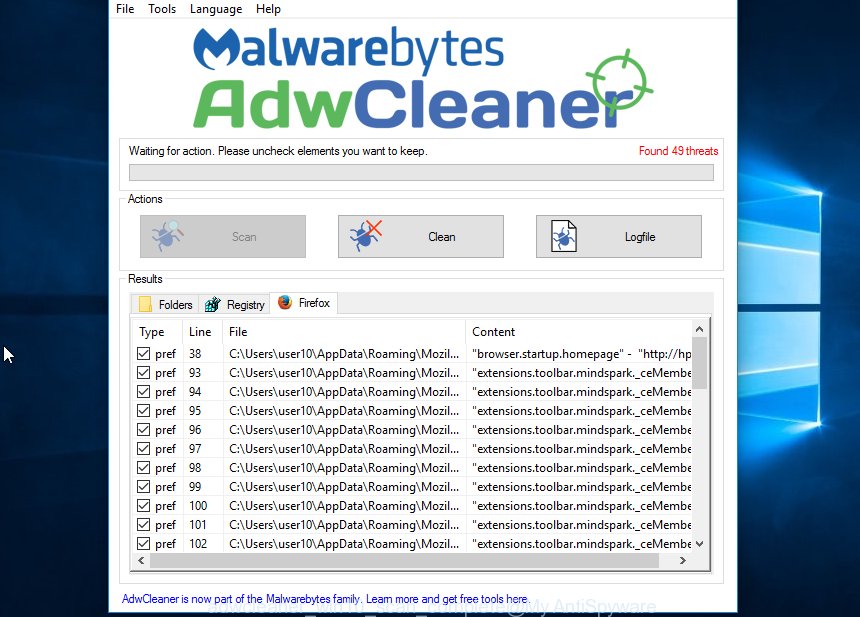
Review the report and then click “Clean” button. It will display a prompt. Click “OK”. When the clean up is finished, AdwCleaner may ask you to reboot your PC.
Look at the following video, which completely explains the process of using the AdwCleaner to remove ad supported software, browser hijackers and other dangerous software.
Finish words
Now your PC should be clean of the redirecting.host ads. Remove AdwCleaner. We suggest that you keep AdGuard (to help you block unwanted popup ads and unwanted malicious web-sites) and Malwarebytes (to periodically scan your machine for new malware and ‘ad-supported’ software). Probably you are running an older version of Java or Adobe Flash Player. This can be a security risk, so download and install the latest version right now.
If you are still having problems while trying to get rid of redirecting.host from your personal computer, then ask for help in our Spyware/Malware removal forum.

